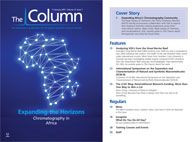International Symposium on the Separation and Characterization of Natural and Synthetic Macromolecules (SCM-8)
A preview of the 8th International Symposium on the Separation and Characterization of Natural and Synthetic Macromolecules (SCM-8).
Photo Credit: S.Borisov/Shutterstock.com

A preview of the 8th International Symposium on the Separation and Characterization of Natural and Synthetic Macromolecules (SCM-8).
The 8th International Symposium on the Separation and Characterization of Natural and Synthetic Macromolecules (SCM-8) will be held from 1– 3 February 2017, in Amsterdam, The Netherlands. SCM-8 is a leading meeting on the characterization of high-molecular-weight analytes covering topics from a wide range of specialties, including analytical chemistry, materials and polymers, and the life sciences. The conference offers a platform for scientists from diverging backgrounds with different perspectives to interact, discuss subjects of mutual interest, and discover new synergies. The latest developments in theory, methodology, technology, and instrumentation will be presented along with a strong focus on solving relevant practical industrial problems.
The SCM-8 programme puts important topics and methods at the foreground with a particular focus on polymer characterization, nonsoluble materials characterization, analysis of soluble polymers, and the separation of veryâhighâmolecular-weight polymers and small particles.
However, difficult problems cannot be addressed by a single technique and may even require several novel approaches. Exciting developments in mass spectrometry to characterize macromolecules are set to be discussed, including new instruments and applications. Developments in spectroscopic techniques, microscopy, and thermal analysis will be discussed and special detectors for macromolecules, such as light scattering and viscometry, will also be on the agenda.
The M•E•A•T (Make, Encounter, Apply, Technology) categories of the SCMâ8 conference consist of a number of important aspects:
The strong connection of the organizers with the polymerâmanufacturing industry, those who MAKE macromolecules, has contributed greatly to the success of previous meetings.
The conference also caters for those who ENCOUNTER natural macromolecules, such as polysaccharides. The nature, composition, and properties of these macromolecules is a key focus of the meeting.
SCM-8 is a vital meeting for all the industries and scientific fields where macromolecules are APPLIED. This includes, among other fields, the food industry, the pharmaceutical industry, and the medical and biological science sectors.
Finally, SCM-8 is a key platform for industries that produce TECHNOLOGY for separating and characterizing natural and synthetic macromolecules.
As well as the diverse background of the speakers from industry and academia, there are many opportunities for young scientists to present their work and interact with the top people in their field. The programme of SCMâ8 will feature a number of plenary lectures by internationally renowned speakers, addressing subjects of broad interest. Keynote lectures will be presented by leading experts and there are many slots in the programme for submitted oral presentations. SCM-8 also features tutorial lectures intended to bring non-specialists up to date on important topics. Stateâofâtheâart overview lectures will provide detailed perspectives on hot topics in the field. Technology providers are invited to share their latest innovations and applications in technical seminars; two one-day short courses on specific topics are being organized and will be announced before the conference. Several awards will be presented during SCM-8, including the SCM Award for an upcoming scientist and the second SCM Lifetime Achievement Award. Finally, SCM-8 will feature a variety of posters presenting specific studies and enabling discussion on all aspects of the work with fellow experts.
The best instrumentation available for analysis and characterization will be on display at the instrument exhibition and ample catering will be provided in the exhibition hall to stimulate scientific and social interactions. Of course, there will be another legendary SCM conference party!
E-mail:info@scm-8.nl
Website: www.scm-8.nl

Characterizing Plant Polysaccharides Using Size-Exclusion Chromatography
April 4th 2025With green chemistry becoming more standardized, Leena Pitkänen of Aalto University analyzed how useful size-exclusion chromatography (SEC) and asymmetric flow field-flow fractionation (AF4) could be in characterizing plant polysaccharides.
Investigating the Protective Effects of Frankincense Oil on Wound Healing with GC–MS
April 2nd 2025Frankincense essential oil is known for its anti-inflammatory, antioxidant, and therapeutic properties. A recent study investigated the protective effects of the oil in an excision wound model in rats, focusing on oxidative stress reduction, inflammatory cytokine modulation, and caspase-3 regulation; chemical composition of the oil was analyzed using gas chromatography–mass spectrometry (GC–MS).









